实验3:OpenFlow协议分析实践
(一)基本要求
HELLO:互相发送Hello消息互相协商Openflow协议版本
控制器6633端口(我最高能支持OpenFlow 1.0) ---> 交换机35220端口
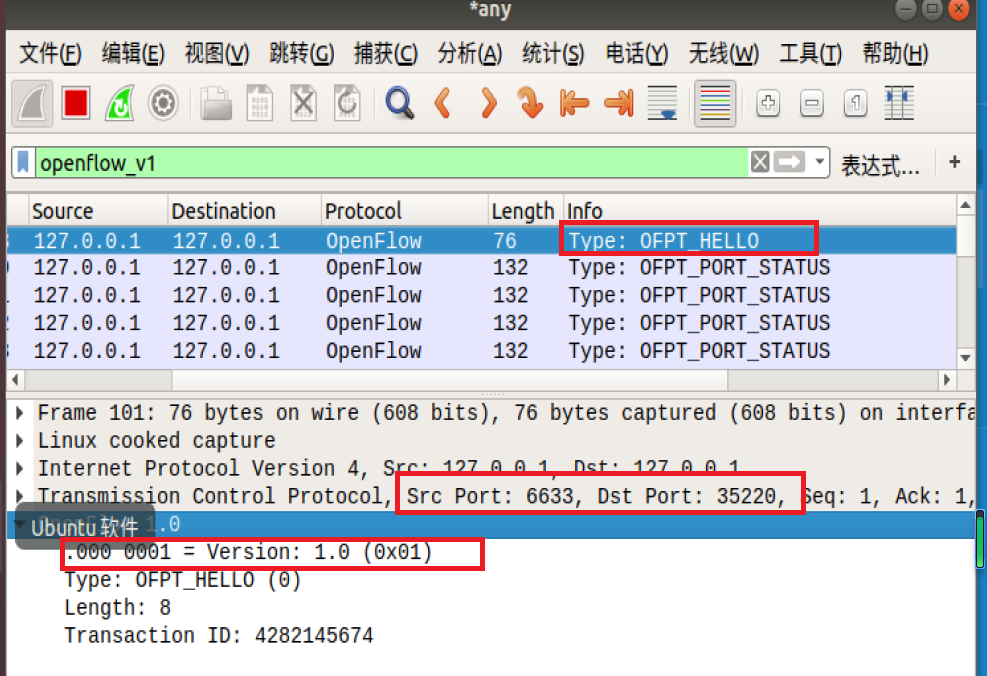
交换机35220端口(我最高能支持OpenFlow 1.4) ---> 控制器6633端口
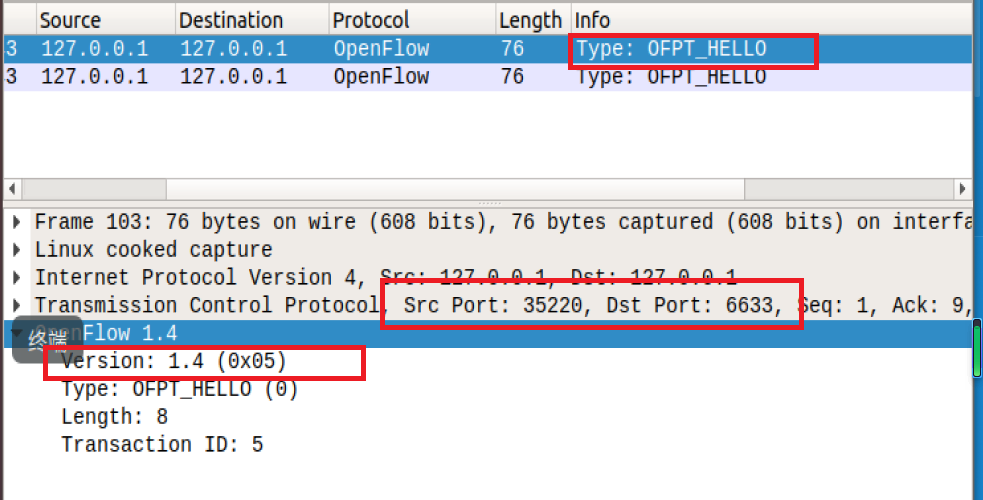
于是双方建立连接,并使用OpenFlow 1.0
Features Request:控制器向将交换机发送Featrues Request消息,获取交换机特征信息
控制器6633端口---> 交换机35220端口
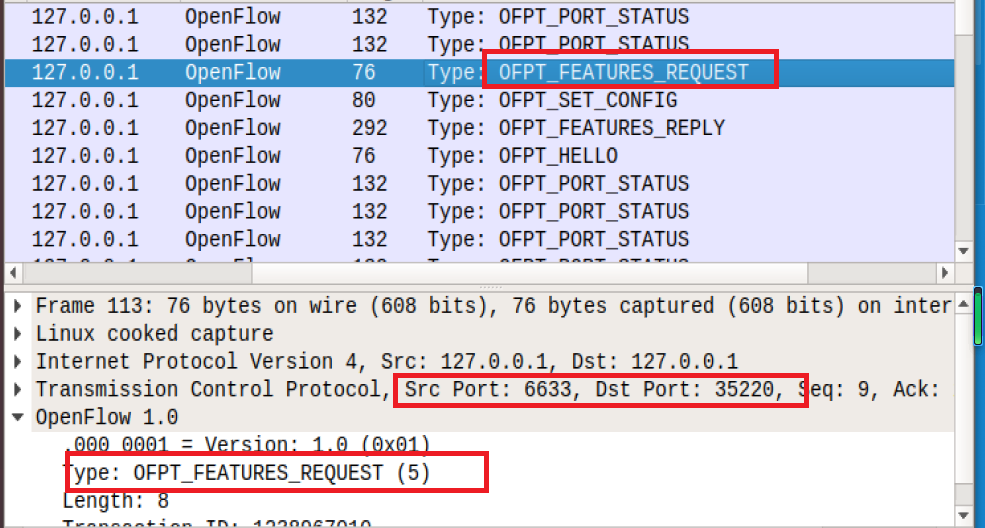
Set Conig:控制器告诉交换机如何配置
控制器6633端口---> 交换机35220端口
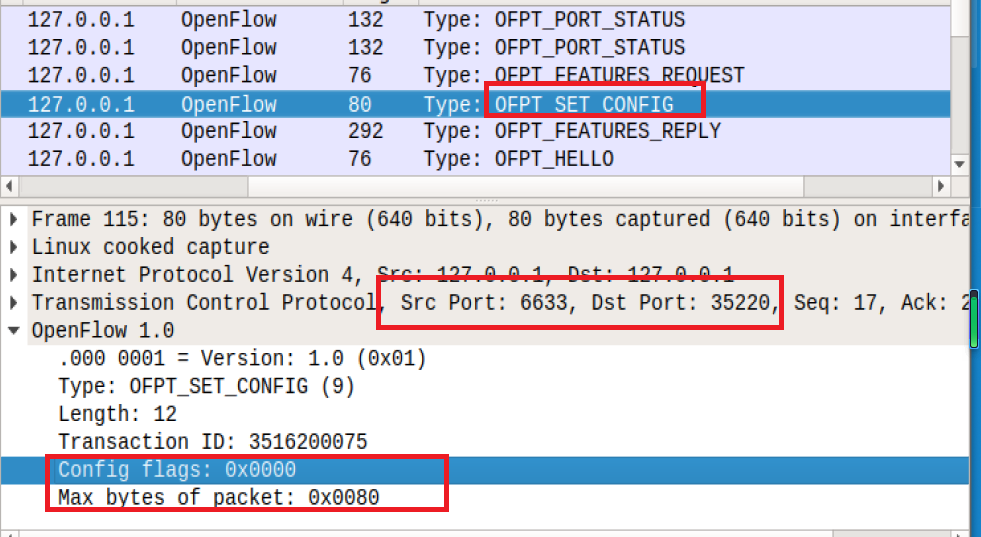
Port_Status:当交换机端口发生变化时,告知控制器相应的端口状态。
交换机35220端口---> 控制器6633端口
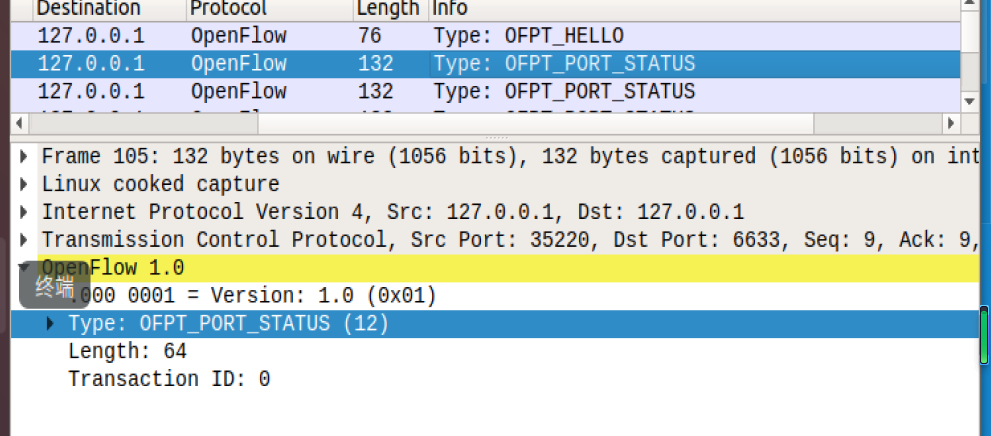
Features Reply:Featrues Request的回复的交换机的特征信息
交换机35220端口---> 控制器6633端口

Packet_in:交换机收到数据包后问控制器如何处理
有两种情况:
- 交换机查找流表,发现没有匹配条目时
- 有匹配条目但是对应的action是控制器时
交换机35220端口---> 控制器6633端口
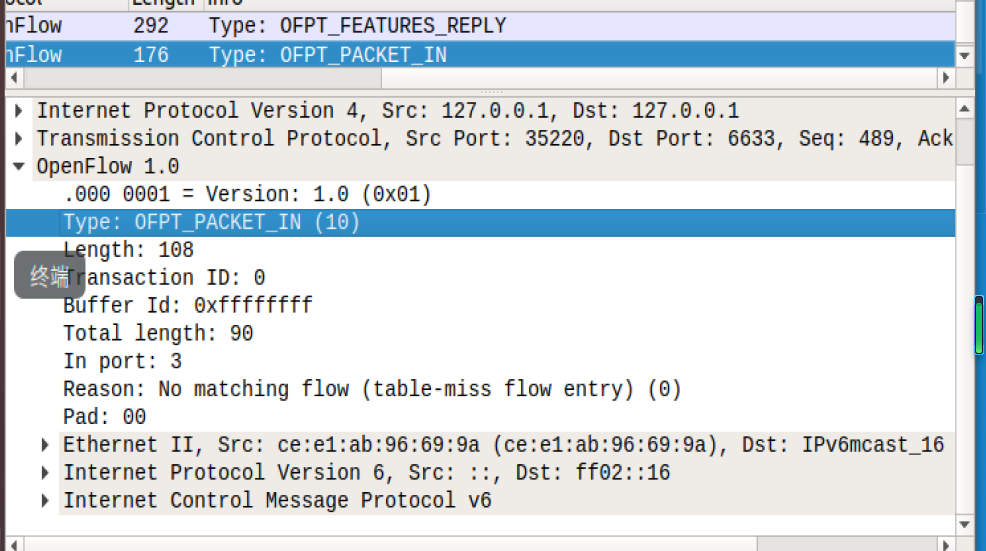
Flow_mod:分析抓取的flow_mod数据包,控制器向交换机下发流表项,指导数据的转发
控制器通过6633端口向交换机35220端口下发流表项,指导数据的转发处理


控制器通过6633端口向交换机35222端口下发流表项,指导数据的转发处理
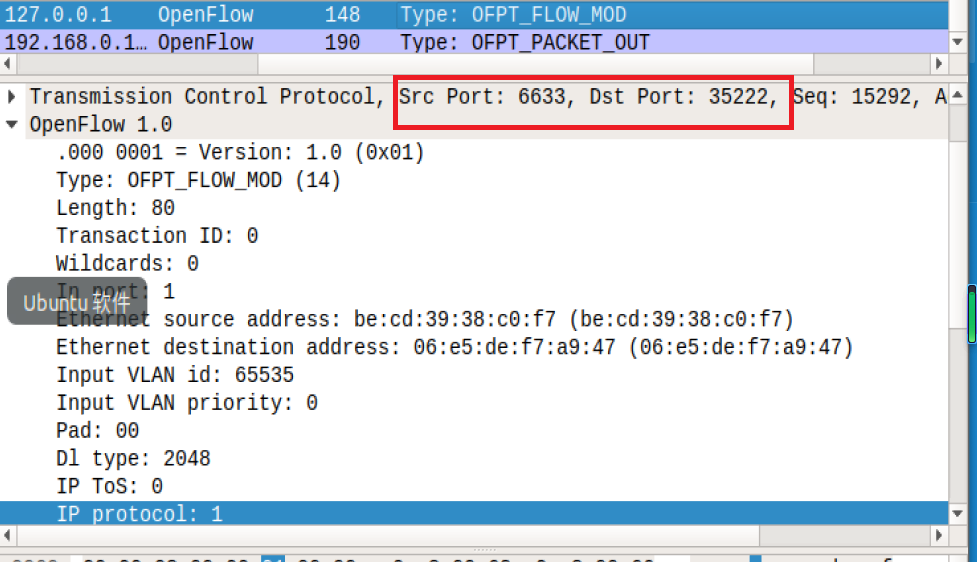
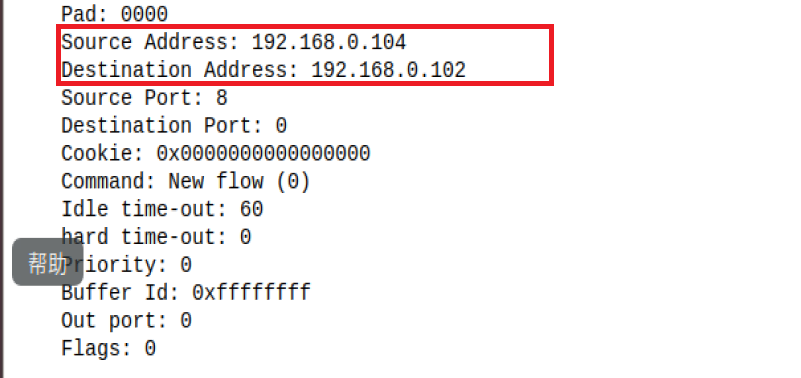
Packet_out:告诉交换机将数据输出到交换机的哪个端口
控制器6633端口---> 交换机35220端口
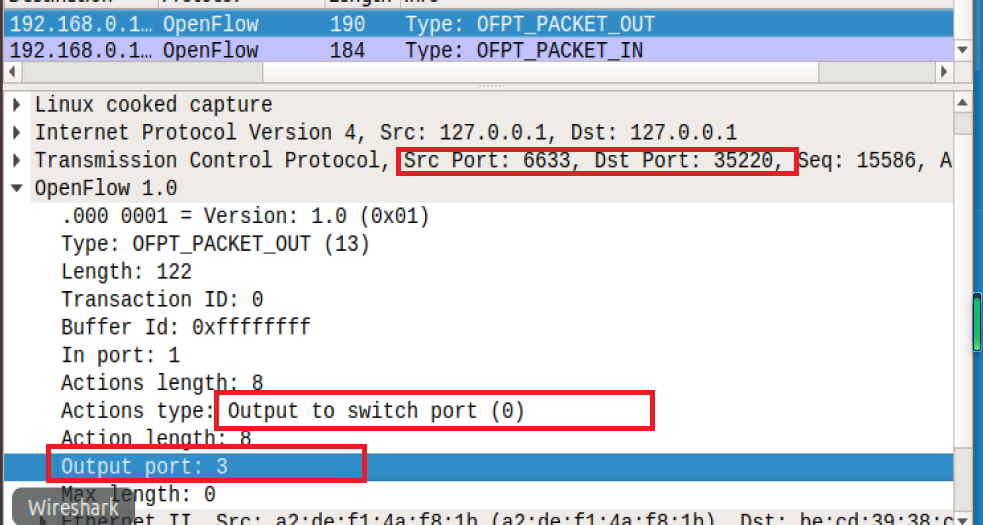
流程图
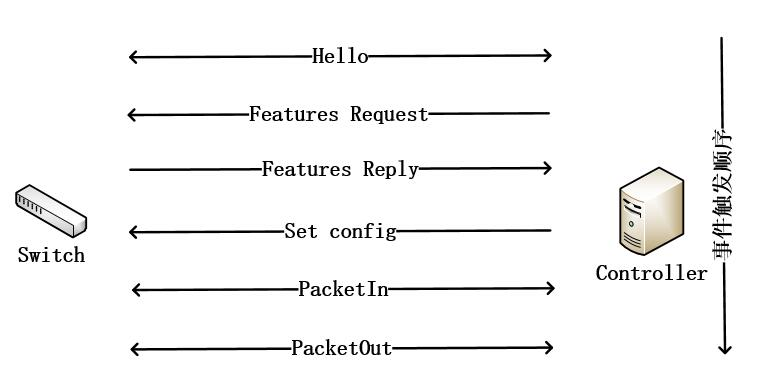
TCP协议
TCP为Transmission Control Protocol的缩写

(二)进阶 OpenFlow主要消息类型对应的数据结构定义
OpenFlow的数据包头通用字段
/* Header on all OpenFlow packets. */
struct ofp_header {
uint8_t version; /* OFP_VERSION. */
uint8_t type; /* One of the OFPT_ constants. */
uint16_t length; /* Length including this ofp_header. */
uint32_t xid; /* Transaction id associated with this packet.
Replies use the same id as was in the request
to facilitate pairing. */
};
OFP_ASSERT(sizeof(struct ofp_header) == 8);
消息类型
enum ofp_type {
/* Immutable messages. */
OFPT_HELLO, /* Symmetric message */
OFPT_ERROR, /* Symmetric message */
OFPT_ECHO_REQUEST, /* Symmetric message */
OFPT_ECHO_REPLY, /* Symmetric message */
OFPT_VENDOR, /* Symmetric message */
/* Switch configuration messages. */
OFPT_FEATURES_REQUEST, /* Controller/switch message */
OFPT_FEATURES_REPLY, /* Controller/switch message */
OFPT_GET_CONFIG_REQUEST, /* Controller/switch message */
OFPT_GET_CONFIG_REPLY, /* Controller/switch message */
OFPT_SET_CONFIG, /* Controller/switch message */
/* Asynchronous messages. */
OFPT_PACKET_IN, /* Async message */
OFPT_FLOW_REMOVED, /* Async message */
OFPT_PORT_STATUS, /* Async message */
/* Controller command messages. */
OFPT_PACKET_OUT, /* Controller/switch message */
OFPT_FLOW_MOD, /* Controller/switch message */
OFPT_PORT_MOD, /* Controller/switch message */
/* Statistics messages. */
OFPT_STATS_REQUEST, /* Controller/switch message */
OFPT_STATS_REPLY, /* Controller/switch message */
/* Barrier messages. */
OFPT_BARRIER_REQUEST, /* Controller/switch message */
OFPT_BARRIER_REPLY, /* Controller/switch message */
/* Queue Configuration messages. */
OFPT_QUEUE_GET_CONFIG_REQUEST, /* Controller/switch message */
OFPT_QUEUE_GET_CONFIG_REPLY /* Controller/switch message */
};
hello和features request
/* OFPT_HELLO. This message has an empty body, but implementations must
* ignore any data included in the body, to allow for future extensions. */
struct ofp_hello {
struct ofp_header header;
};
features reply
/* Switch features. */
struct ofp_switch_features {
struct ofp_header header;
uint64_t datapath_id; /* Datapath unique ID. The lower 48-bits are for
a MAC address, while the upper 16-bits are
implementer-defined. */
uint32_t n_buffers; /* Max packets buffered at once. */
uint8_t n_tables; /* Number of tables supported by datapath. */
uint8_t pad[3]; /* Align to 64-bits. */
/* Features. */
uint32_t capabilities; /* Bitmap of support "ofp_capabilities". */
uint32_t actions; /* Bitmap of supported "ofp_action_type"s. */
/* Port info.*/
struct ofp_phy_port ports[0]; /* Port definitions. The number of ports
is inferred from the length field in
the header. */
};
OFP_ASSERT(sizeof(struct ofp_switch_features) == 32);
set config
enum ofp_config_flags {
/* Handling of IP fragments. */
OFPC_FRAG_NORMAL = 0, /* No special handling for fragments. */
OFPC_FRAG_DROP = 1, /* Drop fragments. */
OFPC_FRAG_REASM = 2, /* Reassemble (only if OFPC_IP_REASM set). */
OFPC_FRAG_MASK = 3
};
/* Switch configuration. */
struct ofp_switch_config {
struct ofp_header header;
uint16_t flags; /* OFPC_* flags. */
uint16_t miss_send_len; /* Max bytes of new flow that datapath should
send to the controller. */
};
OFP_ASSERT(sizeof(struct ofp_switch_config) == 12);
port_status
struct ofp_port_status {
struct ofp_header header;
uint8_t reason; /* One of OFPPR_*. */
uint8_t pad[7]; /* Align to 64-bits. */
struct ofp_phy_port desc;
};
OFP_ASSERT(sizeof(struct ofp_port_status) == 64);
packet_in
/* Why is this packet being sent to the controller? */
enum ofp_packet_in_reason {
OFPR_NO_MATCH, /* No matching flow. */
OFPR_ACTION /* Action explicitly output to controller. */
};
/* Packet received on port (datapath -> controller). */
struct ofp_packet_in {
struct ofp_header header;
uint32_t buffer_id; /* ID assigned by datapath. */
uint16_t total_len; /* Full length of frame. */
uint16_t in_port; /* Port on which frame was received. */
uint8_t reason; /* Reason packet is being sent (one of OFPR_*) */
uint8_t pad;
uint8_t data[0]; /* Ethernet frame, halfway through 32-bit word,
so the IP header is 32-bit aligned. The
amount of data is inferred from the length
field in the header. Because of padding,
offsetof(struct ofp_packet_in, data) ==
sizeof(struct ofp_packet_in) - 2. */
};
flow_mod
enum ofp_flow_mod_flags {
OFPFF_SEND_FLOW_REM = 1 << 0, /* Send flow removed message when flow
* expires or is deleted. */
OFPFF_CHECK_OVERLAP = 1 << 1, /* Check for overlapping entries first. */
OFPFF_EMERG = 1 << 2 /* Remark this is for emergency. */
};
/* Flow setup and teardown (controller -> datapath). */
struct ofp_flow_mod {
struct ofp_header header;
struct ofp_match match; /* Fields to match */
uint64_t cookie; /* Opaque controller-issued identifier. */
/* Flow actions. */
uint16_t command; /* One of OFPFC_*. */
uint16_t idle_timeout; /* Idle time before discarding (seconds). */
uint16_t hard_timeout; /* Max time before discarding (seconds). */
uint16_t priority; /* Priority level of flow entry. */
uint32_t buffer_id; /* Buffered packet to apply to (or -1).
Not meaningful for OFPFC_DELETE*. */
uint16_t out_port; /* For OFPFC_DELETE* commands, require
matching entries to include this as an
output port. A value of OFPP_NONE
indicates no restriction. */
uint16_t flags; /* One of OFPFF_*. */
struct ofp_action_header actions[0]; /* The action length is inferred
from the length field in the
header. */
};
OFP_ASSERT(sizeof(struct ofp_flow_mod) == 72);
packet_out
struct ofp_packet_out {
struct ofp_header header;
uint32_t buffer_id; /* ID assigned by datapath (-1 if none). */
uint16_t in_port; /* Packet's input port (OFPP_NONE if none). */
uint16_t actions_len; /* Size of action array in bytes. */
struct ofp_action_header actions[0]; /* Actions. */
/* uint8_t data[0]; */ /* Packet data. The length is inferred
from the length field in the header.
(Only meaningful if buffer_id == -1.) */
};
OFP_ASSERT(sizeof(struct ofp_packet_out) == 16);
个人总结
- 先抓包再运行python文件生成拓扑
- 通过过滤器输入openflow_v*过滤数据报文的时候,pdf只说了1 4,但是随着版本更新,也可以是 5 6,比如我的交换机发给控制器的hello包支持到openflow 1.4,这个时候过滤器输入openflow_v5才能过滤出来
- 发现找不到Features Request的源码,对比抓包信息后,发现和hello的格式一模一样,因此猜测是同一个源码(跟同学讨论了一下,好像猜对了捏)
- Flow_mod为控制器指导交换机转发发送的数据包,根据这个可知,再Mininet CLI中pingall就可出现然后被捕获
- 了解了OpenFlow协议中交换机与控制器的消息交互过程,了解了wireshark 抓包后的信息大概表示什么内容



【推荐】国内首个AI IDE,深度理解中文开发场景,立即下载体验Trae
【推荐】编程新体验,更懂你的AI,立即体验豆包MarsCode编程助手
【推荐】抖音旗下AI助手豆包,你的智能百科全书,全免费不限次数
【推荐】轻量又高性能的 SSH 工具 IShell:AI 加持,快人一步
· 震惊!C++程序真的从main开始吗?99%的程序员都答错了
· 别再用vector<bool>了!Google高级工程师:这可能是STL最大的设计失误
· 单元测试从入门到精通
· 【硬核科普】Trae如何「偷看」你的代码?零基础破解AI编程运行原理
· 上周热点回顾(3.3-3.9)